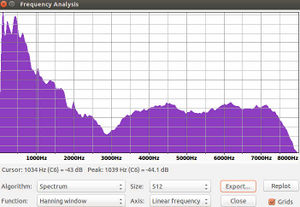Audacity: Difference between revisions
Jump to navigation
Jump to search
No edit summary |
No edit summary |
||
| Line 1: | Line 1: | ||
=Source= | |||
http://www.audacityteam.org/ | http://www.audacityteam.org/ | ||
=How-To= | |||
Audacity works on selections from clip. To select - use View -> Fit in Window to see all. Selection Tool and Zoom Tool are the main tools. Mouse over these to identify these. | |||
=Frequency Analysis= | |||
Recording audio at 16,000 hz can get you, for example, a measurement of engine frequency or misfiring. You can simply plot a frequency of the sound, and look for signatures on certain freqencies. For example, a 3600 rpm single cylinder engine that fires every stroke (revolution rate is 3600 hertz) - you should see a big spike at 3600 hz, with other noise around that. As another example, voice ID can be performed by matching voice against known signatures. [[Image:voicespectrum.jpg|thumb|Sample voice spectrum that can be used for voice identification.]] | |||
=Changing Frequency= | =Changing Frequency= | ||
Revision as of 23:52, 19 April 2016
Source
How-To
Audacity works on selections from clip. To select - use View -> Fit in Window to see all. Selection Tool and Zoom Tool are the main tools. Mouse over these to identify these.
Frequency Analysis
Recording audio at 16,000 hz can get you, for example, a measurement of engine frequency or misfiring. You can simply plot a frequency of the sound, and look for signatures on certain freqencies. For example, a 3600 rpm single cylinder engine that fires every stroke (revolution rate is 3600 hertz) - you should see a big spike at 3600 hz, with other noise around that. As another example, voice ID can be performed by matching voice against known signatures.
Changing Frequency
